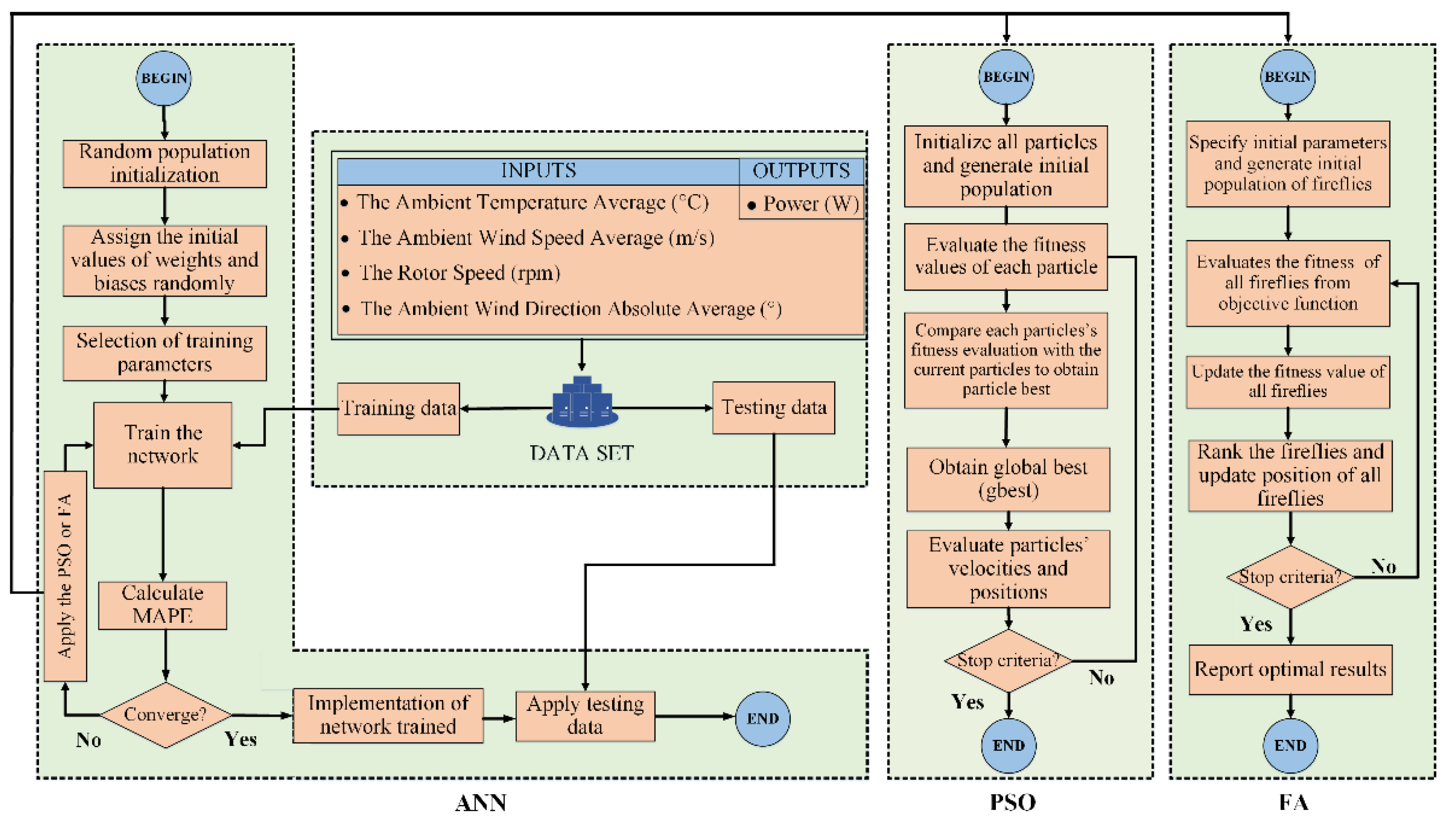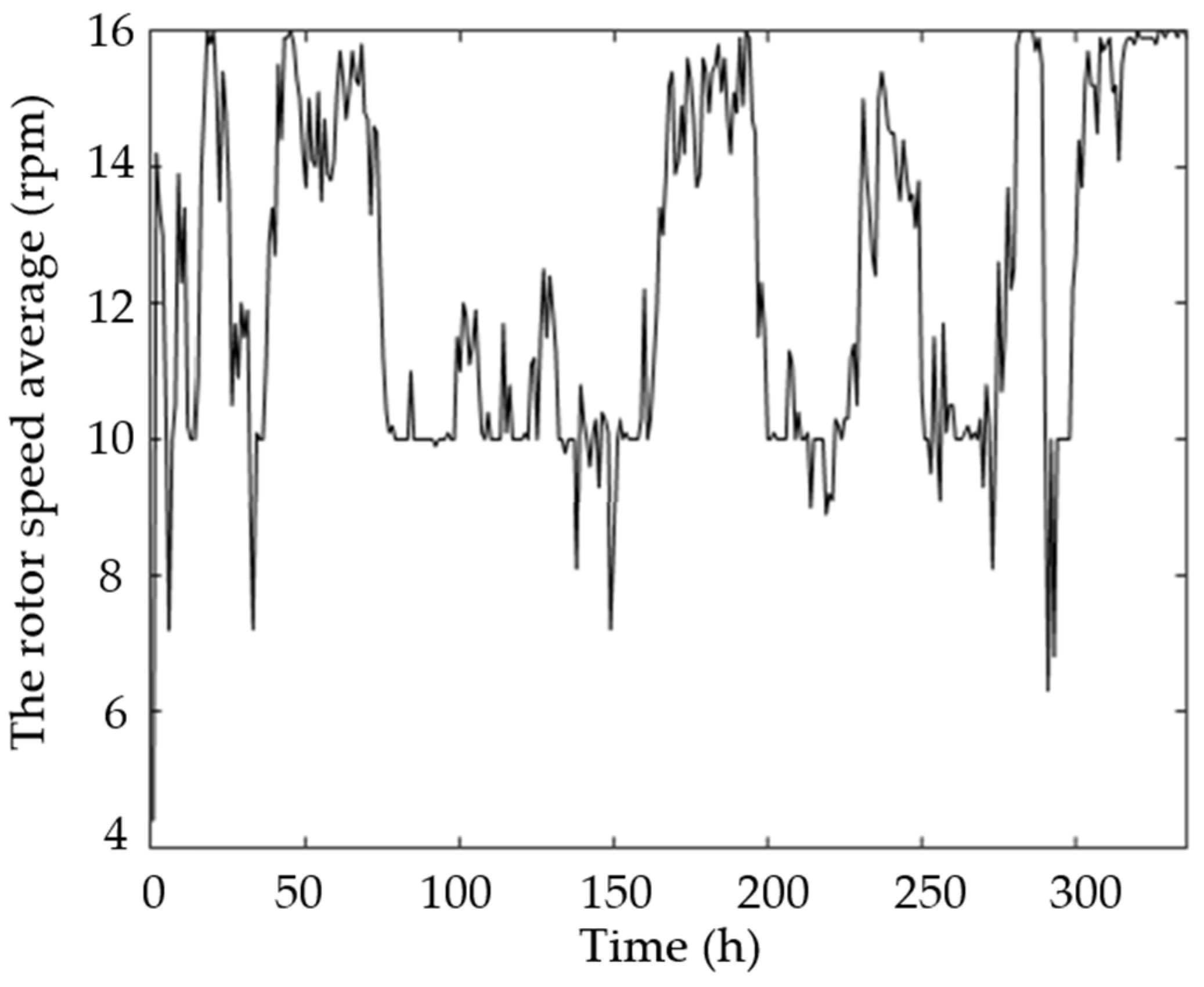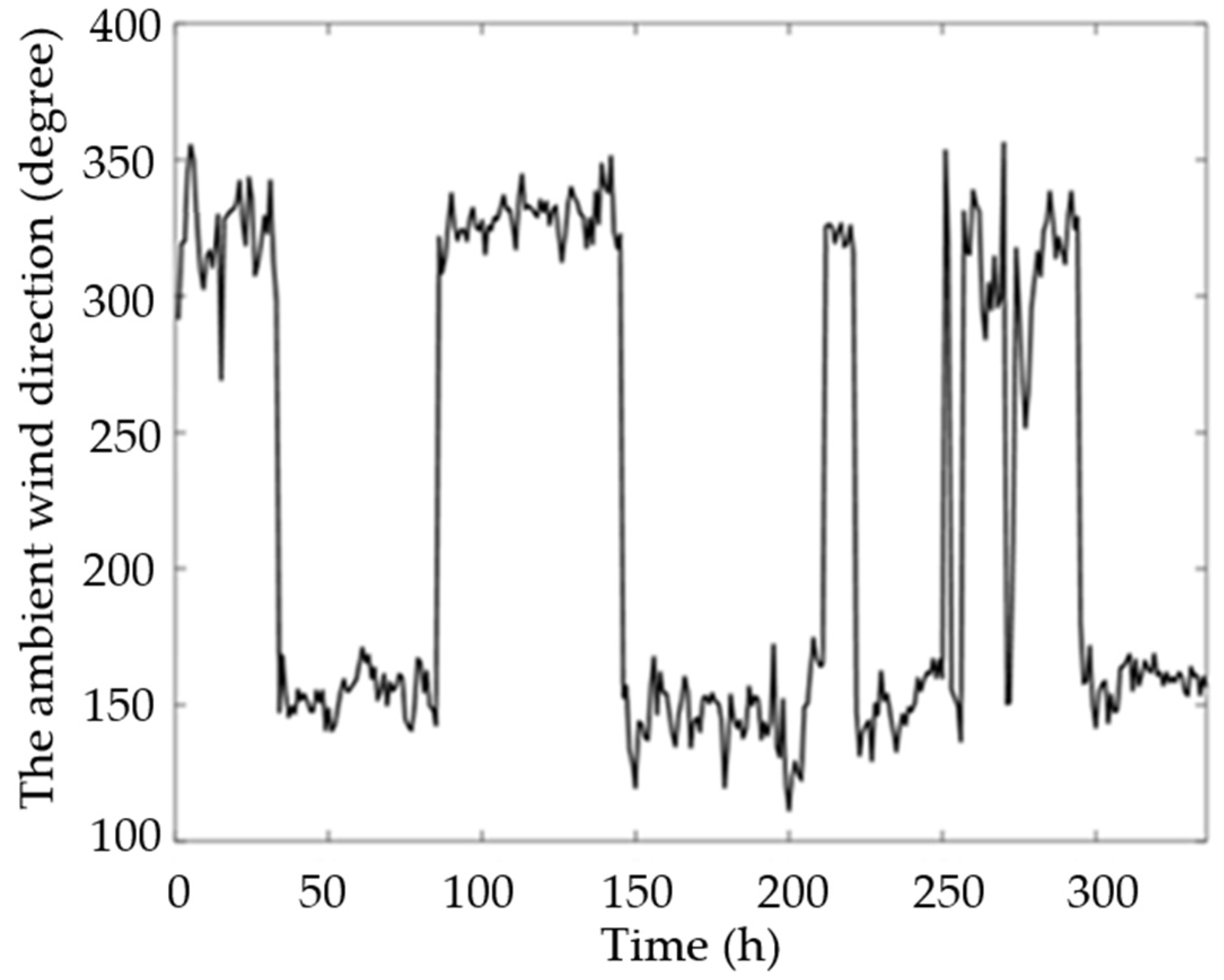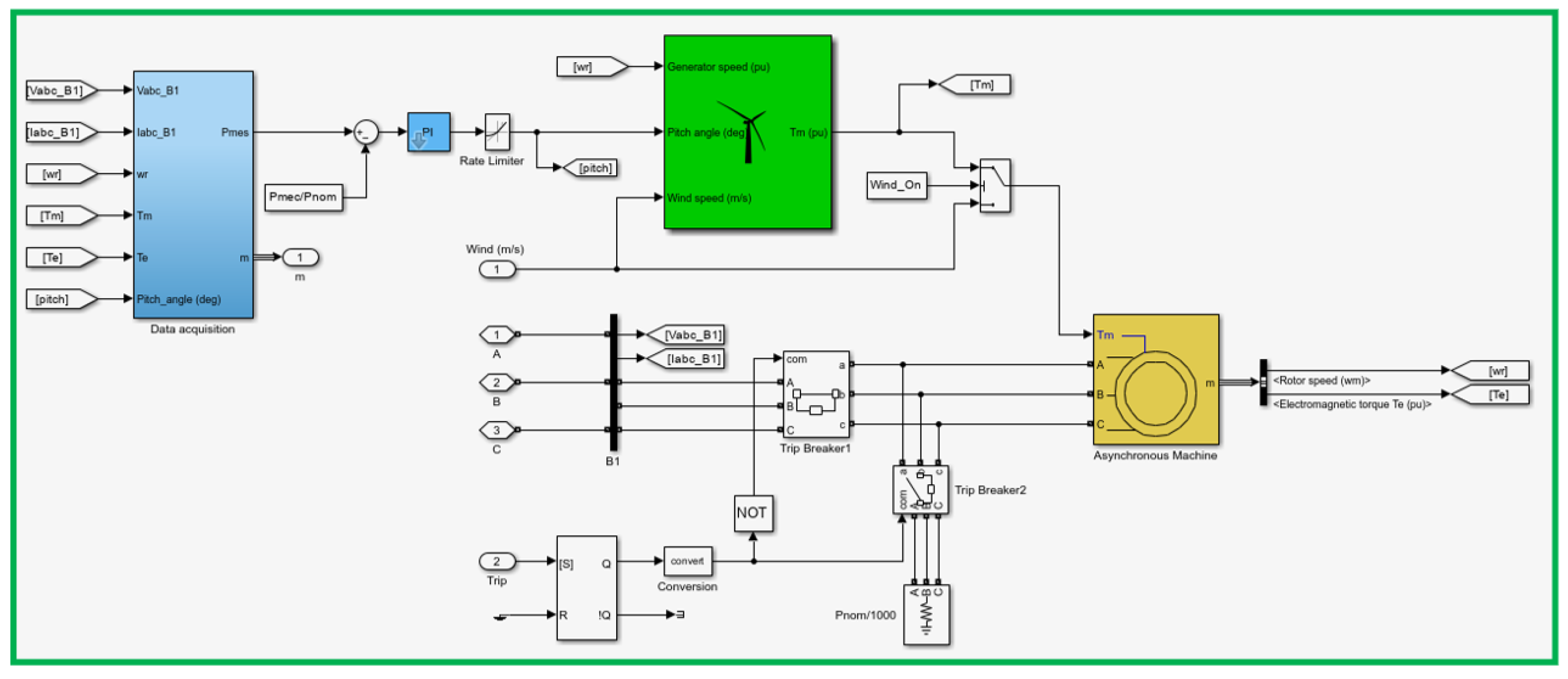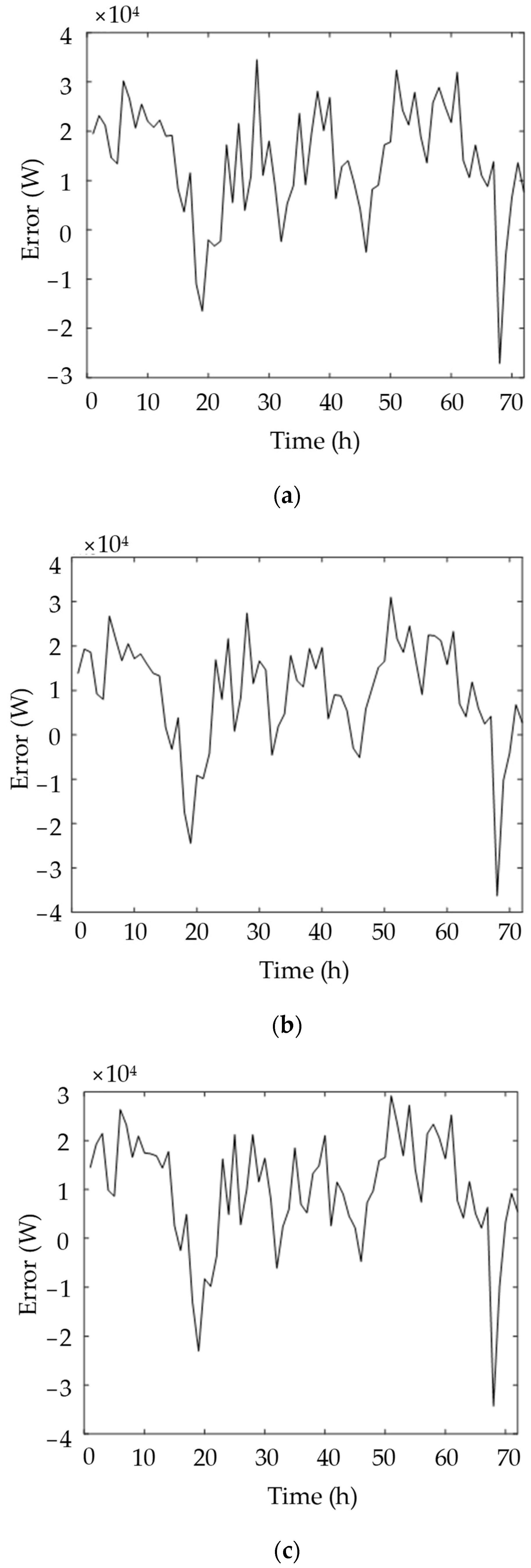1. Introduction
The need to reduce greenhouse gas emissions and mitigate climate change has led to a shift towards cleaner energy sources. Renewable energy helps us decrease our reliance on fossil fuels, which are the primary contributors to carbon dioxide emissions. To meet the rising energy demand sustainably, renewable energy sources, such as solar, wind, hydro, biomass, and geothermal power, have gained prominence [
1,
2,
3,
4,
5]. These sources provide clean, abundant, and renewable alternatives to fossil fuels. As technology advances and deployment increases, the share of renewable energy in the global energy mix is expected to grow significantly in the future. Wind energy is an important and rapidly growing source of renewable electricity, contributing to reducing greenhouse gas emissions and transitioning towards a more sustainable energy future [
6,
7,
8,
9,
10,
11]. Wind power capacity has experienced significant growth worldwide. Many countries have invested in wind energy as part of their efforts to decarbonize their electricity sectors. Offshore wind farms, which are installed in coastal waters, are also gaining traction due to their higher energy potential and reduced visual impact.
Wind energy is highly dependent on weather conditions and, as such, is intermittent and variable. Wind speed and direction can change rapidly, leading to fluctuations in power output. This makes it challenging to match wind energy supply with the constant and predictable demand on the grid. Intermittency requires careful grid management, backup power sources, and energy storage solutions to maintain grid stability. Efforts to address these challenges include advancements in forecasting technologies, grid management strategies, energy storage solutions, and policy frameworks that incentivize grid flexibility and support renewable energy integration. Overcoming these difficulties is essential for maximizing the benefits of wind energy and achieving a sustainable and reliable electricity system. Wind power forecasting helps in the effective integration of wind energy into the electrical grid. By providing accurate predictions of wind power generation, grid operators can better plan and manage balancing the electricity supply and demand. This improves grid stability and reliability. Accurate wind power forecasts enable more efficient operation and utilization of power generation and transmission assets. It helps grid operators optimize the dispatch of power plants, minimize the need for costly backup power, and reduce the reliance on other reserve resources. This can lead to cost savings in the operation of the electricity system.
Wind turbine power forecasting is a critical aspect of wind power integration into the electrical grid and effective power system operation. Several literature reviews have been conducted to analyze the different methods and approaches used in wind turbine power forecasting [
12,
13,
14,
15,
16,
17,
18,
19,
20,
21]. Machine learning algorithms, including text mining, word segmentation, and visualization approaches, have been used to analyze the trends and directions in wind power research [
22]. Deep learning techniques, such as neural and deep learning networks, have also been applied in wind power forecasting [
23,
24].
Machine learning algorithms have been utilized to perform wind power forecasting based on daily wind speed data. The effectiveness of the proposed method is tested in different locations to evaluate whether the algorithms could provide satisfactory results compared to the trained location. The results demonstrated that the eXtreme Gradient Boost (XGBoost), Support Vector Regression (SVR), and Random Forest (RF) algorithms exhibited strong capabilities in forecasting long-term daily total wind power. RF proved to be the most accurate algorithm, achieving an R
2 value of 0.995 and a Mean Absolute Error (MAE) of 7.048. On the other hand, the Least Absolute Shrinkage Selector Operator algorithm performed poorly due to its linear basis, although its R
2 value of 0.862 is relatively acceptable. When the standard deviation was excluded from the dataset, SVR emerged as the best algorithm, with an R
2 value of 0.955 and an MAE of 32.63 [
25]. Efficient wind power prediction is crucial for achieving long-term sustainable development worldwide. However, due to the inherent high variability of wind as an energy source, wind power forecasting poses significant challenges. To address this issue, a new data-driven approach is introduced for wind power forecasting, which incorporates various stages, such as data preprocessing and resampling, in anomaly detection. This approach is based on gated recurrent deep learning models and is presented systematically for the first time. The predictive model incorporates twelve engineered features. The simulation results demonstrate that the proposed approach achieves a high level of accuracy in wind power forecasting while minimizing computational costs. It can be concluded that GRU outperforms LSTM in terms of predictive accuracy across all observed tests [
26]. Accurate and efficient short-term predictions of wind power are crucial for evaluating offshore wind energy and optimizing the operation and maintenance of large wind farms. However, due to the intermittent nature of offshore wind, wind power forecasting remains a challenging task. The model is specifically designed to handle the various components present in the power time series of an offshore wind turbine in Scotland, where both nonlinear and linear characteristics are observed. The developed Discrete Wavelet Transform–Seasonal Autoregressive Integrated Moving Average–Long Short-term Memory model achieves the highest level of accuracy among all the tests conducted, demonstrating its ability to effectively capture complex time-series patterns in offshore wind power data [
27]. A novel hybrid forecasting model was developed to predict the hourly power output of multiple wind turbines. This model takes into consideration both the spatial and temporal correlations between weather factors and power outputs. To capture the time-varying patterns and wind propagation characteristics, a new clustering algorithm called K-means Hierarchical Clustering is employed to adaptively group the wind turbines. Singular Value Decomposition (SVD) is then used to extract the dominant components of the wind power within each cluster. Subsequently, SVR models are constructed for these leading components, and the predictions of these components are transformed back into predictions of the power output for each individual turbine using inverse SVD. Comparative results indicate that the proposed model enhances forecast accuracy compared to the existing short-term forecasting models [
28]. Two methods have been presented for improved probabilistic wind power forecasting using turbine-level data. The first method involves using deterministic power forecasts from individual turbines as explanatory variables in a wind-farm-level forecasting model. The second method is a bottom-up hierarchical approach that infers the wind farm forecast from the joint predictive distribution of power output from individual turbines. Both methods show consistent improvements in forecasting accuracy compared to benchmark models [
29]. A critical review was conducted about wind power forecasting methods, including physical, statistical (time series and Artificial Neural Networks), and hybrid approaches [
30]. A bibliometric analysis of wind speed and power forecasting models was presented for wind turbines in different segments of power systems. The analysis identifies the trends and applications of forecast models based on the forecast time horizon [
31]. The evaluation of wind power forecasts is essential for forecast provider selection, forecast quality control, and model development. Various verification frameworks and diagnostic tools have been proposed to evaluate wind power forecasts. However, it is important to consider the suitability of evaluation tools for different application examples and the significance of the evaluation results [
32]. The study aimed to predict short-term solar irradiance using the Long Short-Term Memory (LSTM) Network and compared its performance with the Artificial Neural Network (ANN) approach. Through statistical tests and error analyses, the prediction outcomes were assessed numerically. Both methods met acceptable error thresholds, but the LSTM method stood out with superior performance. It notably achieved higher accuracy compared to the ANN approach [
33].
These literature reviews provide valuable insights into the different methods and approaches used in wind turbine power forecasting, including physical, statistical, and hybrid models. The studies on wind energy forecasting also highlight the importance of leveraging turbine-level data, the application of machine learning algorithms, and the need for accurate and efficient forecasting techniques to support wind power integration into power systems. In this study, ANN-based swarm intelligence hybrid methods are used to predict wind power output. Hybrid methods combine the strengths of various forecasting techniques to provide more accurate, robust, and adaptable predictions compared to traditional statistical methods. This advantage makes them particularly useful for addressing the complexities and uncertainties present in real-world forecasting problems. In this study, forecasting models are developed that consider multiple objectives, using both conventional machine learning techniques and innovative swarm intelligence methods (ANN-PSO and ANN-FA). For this purpose, the weights and bias values of the Artificial Neural Network were trained with the firefly algorithm. Then, this developed method was used in the prediction phase of the power obtained from wind turbines. In order to show the success of the obtained results, a comparison is made with the results obtained with the ANN and ANN-PSO methods. These approaches aim to enhance the precision of wind power predictions. These models are tested through a case study in Turkey, using real-time wind power data to validate their predictive capabilities. Also, an effective simulation study is presented that reveals the output power performance of the wind turbine using real-time data. The outcomes of our predictions carry significance as they offer reliable and valuable insights into future energy demand. By employing error metrics to assess performance, not only is the accuracy of our forecasts boosted, the efficacy of the methods we employed is also showcased. The accurate wind power forecasts generated in this study hold potential to alleviate the need for excessive reserves and optimize the overall system operation. This achievement contributes to efficient resource utilization and prevents unnecessary limitations in system functionality. This paper provides valuable information for grid operators, energy traders, and system planners, enabling them to efficiently manage and integrate wind energy into the electrical grid. The findings of this paper contribute to the understanding and advancement of wind turbine power forecasting techniques. It supports the transition to a more sustainable and renewable energy future while maintaining grid stability and reliability.
The remainder of this paper is structured as follows. The Materials and Methods, including Artificial Neural Network structure and the hybrid structure of the ANN-based approaches (ANN-PSO and ANN-FA), are presented the
Section 2. The forecast result analysis and conclusions of this paper are discussed in
Section 3 and in
Section 4, respectively.
2. Materials and Methods
2.1. ANN
An Artificial Neural Network (ANN) can be viewed as a collection of interconnected processing elements, also known as nodes or neurons. The network’s capability to perform computations lies in the connection strengths, or weights, between these nodes, which are determined through a learning process using a training dataset.
The typical ANN structure consists of an input layer, an output layer, and one or more hidden layers. Each layer contains multiple nodes, and the output of a node is determined by a mathematical function applied to the weighted sum of its inputs. The input to a node is calculated as the weighted sum of the outputs from other connected nodes. This calculation can be represented by Equation (1) in the context of net input to a node.
In the given equation, wij represents the weights connecting neuron j to neuron i. The outputj corresponds to the output from neuron j, while ui represents the threshold for neuron i. The threshold term acts as a baseline input for a neuron when no other inputs are present. If the weight wij is negative, it is considered “inhibitory” as it reduces the overall net input to the neuron. On the other hand, if the weight wij is positive, it is referred to as “excitatory” since it increases the net input to the neuron.
An Artificial Neural Network (ANN) without hidden units can only solve problems that can be separated by straight lines or planes, known as linearly separable problems. However, it was proven by Cybenko that adding a single hidden layer to an ANN allows it to represent any continuous function, given enough hidden units [
34]. Furthermore, with two hidden layers, an ANN can represent any function. The weights in an ANN, like coefficients in a regression model, are adjusted to solve the problem at hand. This adjustment process is known as learning or training, and it involves finding the appropriate values for these weights. There are two main types of learning in ANN: supervised learning and unsupervised learning. Supervised learning occurs when the training data include known target values for each input. The output of the ANN is compared to the target value, and the difference between them is used to train the ANN by adjusting the weights. Unsupervised learning, on the other hand, is employed when the training data do not provide target output values for input patterns. In this case, the ANN learns to discover patterns or structures in the data without explicit guidance. The ANNs discussed so far are constructed with layers of units, hence referred to as multilayered ANNs. Each layer in such an ANN consists of units that perform similar tasks, contributing to the overall computational process.
2.2. Particle Swarm Optimization
The Particle Swarm Optimization (PSO) algorithm is a widely used heuristic algorithm that takes inspiration from the foraging behaviors observed in bird flocks and fish shoals. Developed by Kennedy and Eberhart in 1995, PSO uses a swarm-based approach to solve optimization problems [
35]. In PSO, each potential solution is represented as a particle, and the particles are initially scattered randomly in the search space. Each particle has a position and a velocity, and its proximity to the optimal solution is determined by a fitness function. As the algorithm progresses, particles adjust their velocities based on their own experiences and the collective behavior of the swarm. This allows them to explore the search space and converge towards the optimal solution. In essence, PSO mimics the movement and interaction of particles in a swarm to find the best solution to a given problem. In the Particle Swarm Optimization (PSO) algorithm, the speed values (
vi) of each particle are updated at each iteration based on the best solution found by the particle itself (
pibest) and the best solution found by the entire swarm (
gbest) up to that point. This update process influences how the particles move and explore the solution space. The iteration is given in Equation (2).
In the PSO algorithm, the update of particle speeds is influenced by various factors. These factors include the current iteration number (
t), the index of the corresponding particle (
i), the particle’s location (
xi), and random numbers (
r1 and
r2) generated in the range [0, 1]. Additionally, there are acceleration coefficients (
c1 and
c2) that play a role in directing the particles towards the local best and global best solutions, respectively. The inertia weight (
w) is another crucial term that determines the balance between local and global exploration. The calculation of the inertia weight (
w) follows a specific formula. The calculation of the inertia weight (
w) is given in Equation (3).
In the Particle Swarm Optimization (PSO) algorithm, the position update of particles is determined at each iteration step using Equation (4). This equation incorporates various parameters to control the movement of particles. The inertia value, represented by
wmax and
wmin, determines the balance between exploration and exploitation in the search process. It influences how much particles rely on their previous velocities when updating their positions. The parameter
k denotes the current iteration number, while
K represents the maximum number of iterations. By adjusting these parameters, the algorithm can dynamically adapt its behavior throughout the optimization process. The position update equation allows particles to adjust their positions based on their own best solution (personal best) and the best solution found by any particle in the swarm (global best). This iterative process continues until the maximum number of iterations is reached, ultimately leading to the convergence of particles towards the optimal solution.
Figure 1 showcases the pseudo-code for the PSO algorithm with Artificial Neural Network (ANN) integration. The pseudo-code consists of five distinct steps, outlining the sequence of actions performed during the algorithm’s operation.
2.3. Firefly Algorithm
The Firefly Algorithm (FA) is a swarm-based optimization method that draws inspiration from the behavior of fireflies in nature. Fireflies utilize their brightness to communicate with each other, protect themselves from predators, and attract potential prey. In this study, the FA algorithm is chosen to optimize the parameters of an Artificial Neural Network (ANN) due to its simplicity, adaptability, and limited number of parameters.
The FA method is based on two important factors: the variation in light intensity and the attractiveness of each firefly (
b). The attractiveness value of a firefly is determined based on its distance from other fireflies. To calculate the distance between two fireflies (
rg), their respective positions (
xi and
xj) are taken into account, following Equation (5).
The level of attractiveness exhibited by a firefly is directly linked to the intensity of the light it emits. When the intensity of light decreases, the level of attractiveness displayed by the firefly also diminishes. The calculation of the firefly’s attractiveness (
) is performed using Equation (6).
The movement of the
ith firefly is determined by its attractiveness compared to other fireflies. If the attractiveness of the
jth firefly is greater than that of the
ith firefly, the
ith firefly will adjust its position accordingly. The equation representing this position change is referred to as Equation (7) in the algorithm.
In the Firefly Algorithm (FA), the movement of fireflies is influenced by various parameters. The equation described in Equation (7) incorporates three components: the current position of the firefly, the brightness of the firefly, and a random movement component when there are no brighter fireflies nearby.
The convergence speed of the algorithm refers to how quickly it reaches a satisfactory solution, whether it is local or global, depending on the values assigned to parameters , , and throughout the algorithm. In this study, a value of and a randomly selected value for parameter a within the range [0, 1] were utilized. The parameter y, which significantly affects the algorithm’s speed of operation, was set to a specific value in practical applications.
Figure 2 presents the pseudo-code for the Firefly Algorithm integrated with an Artificial Neural Network (ANN), comprising five distinct steps that outline the algorithm’s execution.
2.4. Hybrid Structure of the ANN-Based Approaches
Artificial Neural Network (ANN)-based hybrid methods for forecasting combine the strengths of ANN models with other techniques to improve the accuracy and robustness of forecasting models. These hybrid approaches aim to overcome the limitations or enhance the performance of standalone ANN models [
37]. ANN-based hybrid methods have shown significant success in estimating wind output power. The ARIMA-ANN hybrid method combines the Autoregressive Integrated Moving Average (ARIMA) model with an ANN. The ARIMA model captures the linear patterns and autocorrelations in the time-series data, while the ANN handles non-linear relationships and captures complex patterns [
38]. The SVM-ANN hybrid approach combines the Support Vector Machine (SVM) algorithm with an ANN. The SVM model is used to preprocess the data and extract relevant features, which are then fed into the ANN for further analysis and prediction [
39]. In the Wavelet-ANN hybrid method, wavelet analysis is employed to decompose the time-series data into different-frequency components. These components are then fed into an ANN model to capture the patterns at different scales and improve the forecasting accuracy. The GA-ANN hybrid method incorporates Genetic Algorithms (GAs) with an ANN. The GA is used to optimize the parameters and architecture of the ANN, enhancing its performance and adaptability to the specific forecasting task [
40]. In the Fuzzy-ANN hybrid method, Fuzzy Logic and ANNs are combined in this approach. Fuzzy Logic is used to handle uncertainty and linguistic variables, while the ANN learns and models the complex relationships between input and output variables [
41]. These hybrid methods leverage the strengths of different techniques, allowing for more accurate and robust forecasting. They are widely used in various fields, including finance, energy, economics, and weather prediction, to improve the reliability of forecasting models. By integrating the capabilities of ANN models with other techniques, these hybrid approaches have improved the accuracy and reliability of wind power forecasting. Some key points highlight the success of ANN-based hybrid methods in wind power estimation. ANN-based hybrid methods have demonstrated higher accuracy compared to standalone ANN models in wind power prediction. By combining ANN with techniques, like ARIMA, SVM, or wavelet analysis, these hybrid models capture both the long-term trends and short-term fluctuations in wind power, resulting in more accurate forecasts. Hybrid methods help overcome the limitations of ANN models, such as their sensitivity to outliers or noisy data. Techniques, like fuzzy logic or genetic algorithms, incorporated in hybrid models enable better handling of uncertainty and optimization of ANN parameters, making the models more robust and adaptable to varying wind conditions. Hybrid methods allow for the inclusion of exogenous variables, such as meteorological data (wind speed, temperature, humidity), geographical factors, or historical wind power data. By integrating these additional factors, the hybrid models can capture the complex relationships between different variables and improve the accuracy of wind power estimation. Hybrid models can provide accurate short-term (hourly, daily) as well as long-term (weekly, monthly) forecasts of wind power. This capability is crucial for various applications, including grid management, energy trading, and decision making, for wind farm operators. Overall, ANN-based hybrid methods have shown great success in estimating wind output power by combining the strengths of ANN models with other techniques. These hybrid models provide more accurate and robust forecasts, contributing to the effective integration and utilization of wind energy in the power system.
This study focuses on the short-term power forecasting of wind turbines using hybrid approaches. Three different methods, namely Artificial Neural Network (ANN), ANN with Firefly Algorithm (ANN-FA), and ANN with Particle Swarm Optimization (ANN-PSO), are employed to process the data effectively. The structure of the proposed hybrid wind power forecasting models is shown in
Figure 3. The performance of these models is evaluated using metrics, such as Mean Absolute Percentage Error (MAPE), coefficient of determination, and correlation coefficient. The analysis focuses on comparing the accuracy and reliability of the ANN, ANN-PSO, and ANN-FA methods in forecasting wind power. The ANN algorithm is trained with various optimization techniques, and a comprehensive analysis of their performance is conducted. The objective is to identify the algorithm that achieves the lowest error in power forecasting. The findings of this study offer valuable insights and techniques for researchers involved in wind power plant planning and modeling, providing them with useful tools to enhance their forecasting capabilities.
4. Conclusions
Wind power has gained significant popularity as a renewable energy source to meet the growing energy demand. Numerous studies have been conducted to maximize the utilization of this abundant resource. However, harnessing wind energy is not feasible at all times due to various factors, such as cloudiness, dust, and fluctuations in wind velocity and direction. These factors make wind energy generation unpredictable and lacking a stable behavior pattern. In the electricity grid, it is crucial to maintain a delicate equilibrium between electricity consumption and generation. Imbalances in this equilibrium can lead to disruptions in the quality and availability of power. Unlike traditional power generation methods, which can be adjusted as needed, wind power generation depends directly on wind speed and lacks immediate controllability. Consequently, fluctuations in wind power output necessitate compensatory power from alternative sources, which might not always be readily accessible at short notice. This challenge becomes even more intricate as wind power contributes a larger share of the total electricity supplied to the grid. This underscores the pivotal role of accurately predicting wind power generation. Thus, the prediction of wind power is essential for upholding the stability of the entire power grid, as they enable timely adjustments and interventions to counterbalance the variable nature of wind energy.
Accurate wind power forecasting is crucial for effective energy planning, which motivated this study. Real-time data from a wind power plant in Turkey are employed to estimate the output power for short-term prediction. Moreover, MATLAB/Simulink is utilized to present a simulation study of a real wind power system under various wind speeds. Initially, traditional ANN models are used for forecasting, but the results fall short of expectations. It is observed that the limited input parameters used in the traditional ANN approach are insufficient for accurate estimation. To enhance performance, the ANN models are combined with optimization methods to optimize the input data. Specifically, the ANN models are optimized using Particle Swarm Optimization (PSO) and the Firefly Algorithm (FA), and their results are compared in detail. The performance analysis reveals that the traditional ANN algorithm alone is insufficient to predict short-term output power using a limited set of input data. Previous literature attempts have employed PSO, one of the commonly used optimization methods, to achieve optimal predictions. However, due to the inherent limitations of PSO, such as becoming stuck in local minimum values, the desired performance is not achieved. In contrast, the FA, a novel optimization method, has shown superior efficiency in short-term wind power prediction by effectively addressing the issue of being trapped in local minimum values. The superiority of the Firefly Algorithm (FA) over Particle Swarm Optimization (PSO) lies in its capacity to optimize and fine-tune the parameters of the forecasting model more effectively. FA is adept at mimicking the behavior of fireflies, which display dynamic movement patterns and attract each other through luminous signals. This unique approach allows FA to swiftly converge toward optimal solutions in complex, multi-dimensional optimization problems. In comparison, while PSO also harnesses a swarm-based approach, it might struggle to strike the right balance between the exploration and exploitation of the solution space. PSO’s particles can converge prematurely to suboptimal solutions, especially in intricate and nonlinear optimization scenarios. FA’s ability to dynamically adjust its search behavior and exhibit more robust exploration, coupled with its efficient convergence to optimal solutions, grants it an advantage in scenarios like wind power forecasting, where precision is vital. The evaluation of the outcomes demonstrates that, during the testing phase, the ANN-FA approach exhibited the smallest error. Upon examining the numerical data, it becomes apparent that the ANN-FA method surpassed the alternative techniques in its effectiveness for predicting wind power.


